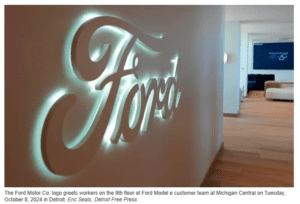1973 Porsche 911 Carrera RS 2.7: The Legend Starts Here

Thomas Haas has a problem: He has too many Porsches. The man in charge of maintaining the collection of the Porsche Museum has a superabundance of riches in his care. There are more than 700 cars in this automotive archive, with around half living in the huge warehouse/workshop in the Stuttgart suburb of Kallenberg that Haas is showing us around. It is an Aladdin’s Cave of riches: race cars, prototypes, concepts, one-offs, plus drivable examples of almost every car Porsche has ever produced.
Some models seem obviously over-represented, with one aisle featuring half a dozen 918 Spyders, for instance. “It is hard to say no to anybody who offers you a 918 Spyder,” Haas says, wistfully. “I would not say we have too many. But we certainly have many.”
We’ve come to Germany to celebrate an earlier period of Porsche’s history, however. This year marks the 50th anniversary of the 911 Carrera RS 2.7, one of the company’s most famous models and one that pioneered what would later become the GT and RS road cars produced by the company’s Motorsport division right up to the present day. Porsche offered the chance to drive two immaculate examples as part of a hands-on history lesson involving both the company’s comprehensive archive and the chance to talk to one of the men who worked on the pioneering project.
Humble Origins
Although it has long been regarded as one of Porsche’s pinnacle products, the RS 2.7 was developed on a shoestring budget. It was also born from failure—specifically, the difficulty that the regular 911 was having being competitive on racetracks. The FIA’s Group 4 regulations offered the chance to create a more aggressive version, but there was little money and no ability to make major changes. The biggest issue for the standard car was aerodynamic lift, the 911’s gently sloping rear creating a low-pressure area that created instability at high speeds. So, in 1972, an aerodynamicist named Hermann Burst who had previously worked on the all-conquering 917 racer car was asked to find a way to improve matters.
“The problem was that we weren’t supposed to change the original shape of the 911,” says Burst, now 81 and still happy to talk about his famous project. “So, we were looking for the simplest way to improve both drag and lift.”
The solution arrived at by his tiny team was a cleverly shaped rear spoiler, the famous duck tail. Working in conjunction with a front air dam, it produced rear-end downforce, reduced drag, and—another useful side effect—improved the cooling for the air-cooled flat-six hung behind the rear axle. Germany’s regulators weren’t happy with the idea, fearing any motorcyclists hitting the sharp edge of the spoiler would be badly injured, so Porsche agreed to limit the height of the wing and said production of the roadgoing version would be capped at the 500 units necessary for homologation. (This latter promise was quietly forgotten; 1580 examples of the RS 2.7 were eventually made.)
Porsche made some other, less radical changes too. The car got wider rear tires, bodywork made from thinner-gauge sheetmetal, and thinner glass. Sound insulation was removed too. The suspension was upgraded with stiffer springs and thicker anti-roll bars, plus new rear control arms and upgraded crossmembers. Curb weight for the fully decontented Sport version—which did without carpeting, rear seats, a dashboard clock, or even a glove compartment lid—was claimed to be just 2116 pounds.
Engine upgrades were more limited. The enlarged 2.7-liter engine used the same valves and compression ratio as the existing 2.4, but with a bigger bore boosting capacity and increasing power to a peak 207 horsepower. (More sizable power increases arrived with the first 911 Turbo three years later.) The 2.7-liter 911 was one of the quickest sports cars on the planet, with a likely conservative claim of 5.8 seconds from zero to 62 mph (we achieved 5.8 seconds to 60 mph with a lower-powered and heavier 1974 Porsche 911S Carrera) and a 152-mph top speed.
Lastly, there was the need to find a name for this range-topping model. The Carrera name had previously been used for range-topping versions of other models, inspired by Porsche’s successes in La Carrera Panamericana in the 1950s. A young Dutch designer called Harm Lagaay—who ultimately became Porsche’s head of design—was given the task of creating a suitable typographical logo for the name, creating the famous silhouetted script that spanned the wheel arches on the side of the car. The RS branding came from Renn Sport, or “racing sport,” an encapsulation of the car’s brief.
Taking the Wheel of a Legend
Fascinating as the RS 2.7 is on a theoretical level, the practical demonstration of the car’s talents is what’s really special. Persuading anybody to let you have a go in an original RS 2.7 is going to be difficult. Prices of even an average example of the Touring version will run well past $500,000, with the most cossetted and lowest mileage Sport variants getting into seven figures. The museum actually let me drive two from its collection, a yellow Touring and a white Sport.
Both are in immaculate condition. Driving older cars usually means experiencing the foibles that time has introduced as well as the ones they were made with. That isn’t the case here—both cars feel as if they have slipped through a five-decade time portal and arrived in factory fresh condition. There are no visible blemishes inside or out, and they drive without any of the knocks or creaks that usually come with age.
The RS feels tiny. The cabin is narrow enough that the lack of electric windows isn’t an issue: I can easily reach across to operate the winder on the passenger side. The floor-mounted pedals feel awkward and are positioned with a sizable offset between brake and gas, one that together with the limited legroom makes it almost impossible to manage smooth heel-and-toe rev matching. The unassisted steering feels low-geared compared to any modern sports car but is beautifully weighted as soon as the car started to move and is rich in feedback. The shifter for the five-speed transmission lacks the resistance and tightly corralled gates of a modern Porsche manual but is finger-light and accurate.
Don’t Drive It Too Gently
Upshifting with the deference due a museum piece made the RS initially seem underwhelming. The engine has a nice, metallic harmony at lower revs, but it lacks midrange muscle, and its obvious desire to rev soon persuaded me to push harder. Doing so made it clear that the best is reserved for the very top of the rev range, where acceleration turns keen even by modern-century standards as the central tach’s needle closes in on the 7200-rpm redline.
While the modest grip produced by the 15-inch Pirelli Cinturato tires felt closer to that of a Miata than the Velcro adhesion of a 992-generation 911 Carrera, the RS flags its limits clearly and encourages the driver to try and find them. The steering lightens perceptibly as front-end grip begins to fade, with the rear axle’s attitude easily altered by gently easing the throttle. You’ll be unsurprised that I didn’t try to provoke any of the lift-off oversteer that early 911s were infamous for, but on the smooth, dry roads there was no sense of snappiness.
Switching to the RS Touring proved that dynamic differences between the two cars are barely perceptible, but also that I actually preferred the slightly plusher car. While the Sport’s bucket seats gripped aggressively, the Touring’s offered less lateral support, but their greater flexibility allowed a useful increase in legroom. Plus, it has a clock, and who doesn’t want to tell the time?
Older cars often feel like a museum piece when viewed through the prism of modern experience—slow and soft and imprecise, even if replete with the cultural associations we love them for. But the 911 Carrera RS 2.7 is a museum piece that has both huge cultural resonance and a compelling driving experience. The various lightweight 911 derivatives that have followed, through GT and RS incarnations, have been faster and grippier. But none has possessed the significance of this early pioneer.
A car-lover’s community for ultimate access & unrivaled experiences. JOIN NOW
This content is created and maintained by a third party, and imported onto this page to help users provide their email addresses. You may be able to find more information about this and similar content at piano.io





